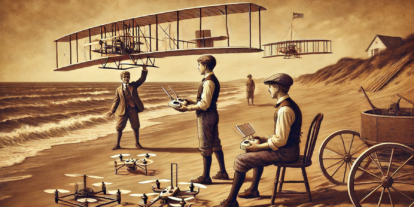Below is an excerpt from Women and Drones Vertical Space Magazine Summer 2022 Issue of an article written by Aloft Head of Community, Erica Cooley about the essential and evolving role of drone technology in disaster response. You read the full Summer 2022 Issue of Women and Drones Vertical Space Magazine here.
Dr. Robin R. Murphy is the Raytheon Professor of Computer Science and Engineering at Texas A&M University, a director of the Center for Robot-Assisted Search and Rescue (crasar.org), and an AAAS, ACM, and IEEE Fellow. Dr. Murphy has deployed ground, aerial, and marine robots to over 30 disasters in five countries since the 9/11 World Trade Center. She led the first use of small drones for a disaster, Hurricane Katrina, in 2005 with subsequent deployments to Fukushima, Hurricane Harvey, the Surfside collapse, and numerous other floods, landslides, and hurricanes. Her experiences are captured in a TED talk, 150 papers, and four books including the award-winning Disaster Robotics.
Listen to the full episode on the B4UFLY Check the Map poodcast with Dr. Robin Murphy, Director of the Center for Robot-Assisted Search and Rescue below.
Helping Hearts of Service: Drone Use in Disaster Relief Missions
A fascinating discussion with Dr. Robin Murphy, Director of the Center for Robot-Assisted Search and Rescue on the essential and evolving role of drone technology in disaster response.
Every day innovative minds around the world find new ways to use drones to improve the quality of life and solve important problems to change our world and the way we live. Dr. Robin R. Murphy, Raytheon Professor of Computer Science and Engineering at Texas A&M University and a director of the Center for Robot Assisted Search and Rescue (crasar.org) is one of those innovative individuals reshaping the landscape of disaster relief missions using drone technology.
Dr. Murphy has deployed ground, aerial, and marine robots to over 30 disasters in five countries since 9/11. Leading the first use of small drones for a disaster, Hurricane Katrina, in 2005, she has led subsequent deployments to Fukushima, Hurricane Harvey, the Surfside collapse, and numerous other floods, landslides, and hurricanes.
Recently, I had the opportunity to discuss with Dr. Murphy about her nearly 30 years of experience as an academic and disaster relief. During our discussion on Aloft’s B4UFLY Check the Map podcast (listen to the full epsiode below), Dr. Murphy shared her incredible stories of integrating UAS technology into disaster relief response from hurricanes, earthquakes, landslides and all types of disasters.
“My background is a bit odd- I am a traditional academic working as a professor, doing research in artificial intelligence applied to robotics. In 1995, I became involved in using robots for disasters. I started with ground robots at 9/11 and subsequent events. In the early 2000s, drones started to come in the field. During Hurricane Charlie, I was working as a technical search specialist, I observed ground robots were not a great tool during a hurricane. In observing aerial systems at the time, we realized how helpful it would have been to the emergency managers to see the aerial perspective to aid in effectively responding during the hurricane. Following when Hurricane Katrina hit in 2005, this was the first time small uncrewed aerial systems were used by emergency responders and we have been using this technology ever since. Since then, we have also added marine-based vehicles because 80% of the population [in the U.S.] lives by water. So these tools are important as well.”, Dr. Murphy stated.
Our discussion progressed to how UAS technology has evolved over the years, going from potentially unreliable connectivity in a drone which cost upwards of $75K in the early 2000s to now nearly twenty years later, UAS being highly reliable, extremely cost effective and including many advanced features like LIDAR, thermal imaging, etc. Though, Dr. Murphy expressed she still feels adoption of this incredible technology has a long way to go and training is a key element to educating operators for specialized uses of drones.
As an academic, Dr. Murphy’s passion and expertise in educating bright minds on the use of robotics to solve problems in real world applications intersected with the Women and Drones organization recently. This past May, Dr. Murphy led a threeand a half day drone pilot training for disaster response in College Station, Texas for Women and Drones members. At the Women and Drones’ Disaster Response Training, participating drone pilots received hands-on flying as well as the important, but often overlooked, aspects of data management and the expectations of emergency managers. Participants had one and a halfdays of handson training, then flew missions under realistic operating conditions at Disaster City and nearby emergency management training facilities at Texas A&M.
“I and my colleagues greatly enjoyed training Women and Drones members on the missions and skills needed for flying for most types of disaster response- hurricanes, floods, tornadoes, and even active shooter eventsand getting to know the next generation of pilots,” said Dr. Murphy.
Dr. Murphy shared insights from her experiences of why training programs like the collaboration with Women and Drones are so important for those passionate about using drones to aid in disaster response.
“We see a lot of people thinking, I have some skills and equipment, I’m just going to show up and help at a disaster like a flood or hurricane. This situation is not so nicely referred to as disaster tourism. In these disaster situations you can not just show up uninvited. For instance, during Hurricane Harvey we had people showing up with drones wanting to help, not realizing that our teams already had drones and now more people were being added to a disaster area already experiencing food, fuel, water and lodging shortages. Effective disaster response includes a lot of specialized knowledge, expertise and procedures that you and I would not know about unless trained specifically with the group you are going to the field with. Therefore, if you are interested in using drones for disaster response you need to receive the trainings and work with your local agencies in advance so when an emergency situation occurs it is easy for the entire team to work together to be effective.”, stated Dr. Murphy.
Dr. Murphy concluded our conversation with this advice to those who have a heart of service and a passion for learning how to use UAS technology to aid in disaster response, “I’d like everyone to remember, not so much don’t be a ‘disaster tourist’, instead, don’t be the person who doesn’t use your great skills, equipment, and heart to help during the wake of a disaster. Just use your drone equipment and skills in the right way by getting in contact with your local agency, start taking the disaster response courses and trainings, and work with the local organizations to get involved and connected. Then let us know your success stories using UAS technology for disaster relief because as scientists we are always trying to keep up in this rapidly changing field.”
You can learn more about the work and trainings Dr. Murphy and her team at CRASAR provide at crasar.org. Listen to the full discussion with Dr. Murphy on the B4UFLY Check the Map podcast below. Stay up to date about future Women and Drones Disaster Response workshops here.
Check out Aloft’s B4UFLY Check the Map Podcast: Helping Hearts of Service: Drone Use in Disaster Relief Missions with Dr. Robin Murphy, Director of the Center for Robot-Assisted Search and Rescue. In this episode, Aloft Head of Community, Erica Cooley & guest host, Dr. Robin Murphy, fellow Part 107 certified drone pilot, Raytheon Professor of Computer Science and Engineering at Texas A&M University, and director of the Center for Robot-Assisted Search and Rescue, discuss how robotics specifically drones are being used for disaster relief missions, the importance of training programs like the one’s offered by the Center for Robot-Assisted Search and Rescue and much more.
If you have a drone airspace challenge area, situational awareness topics, or general UAS operational question you would like discussed in an upcoming episode please email your question to erica@aloft.ai. Subscribe for new episodes released bi-weekly.
Erica Cooley
Erica Cooley is Aloft’s Head of Community, she’s responsible for connecting with the expanding drone community to provide educational opportunities on how to leverage technology to fly with compliance and safety. Erica is an FAA-certified Part 107 Remote Pilot since 2017. Her passion for gender and diversity inclusion in the UAS industry is demonstrated as a proud member of Women and Drones & a brand ambassador for Women Who Drone. She is also an FAA Safety Team Representative in the Seattle, WA area. Erica received her BA from the University of Puget Sound in Communication Studies.



